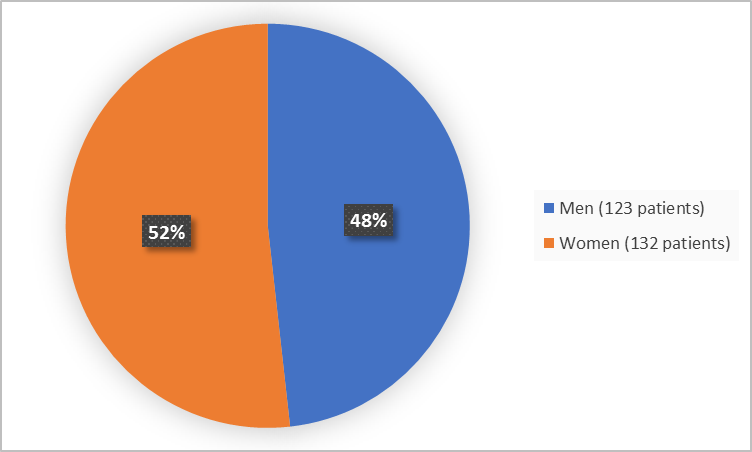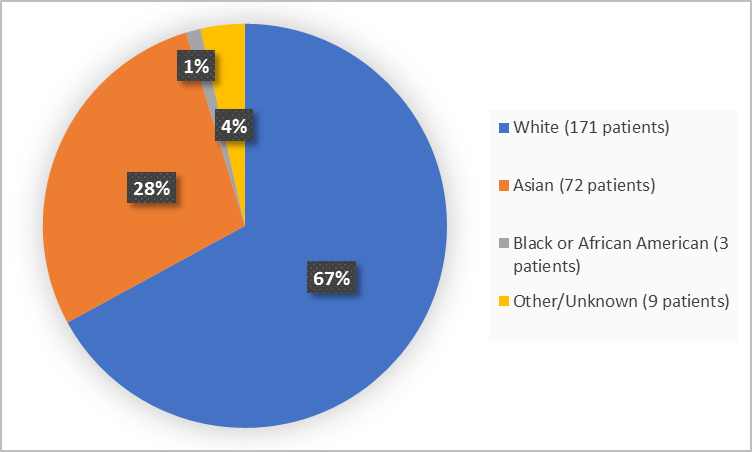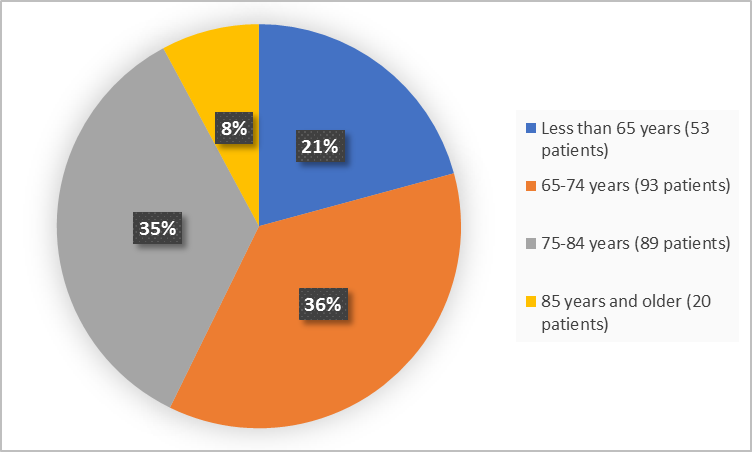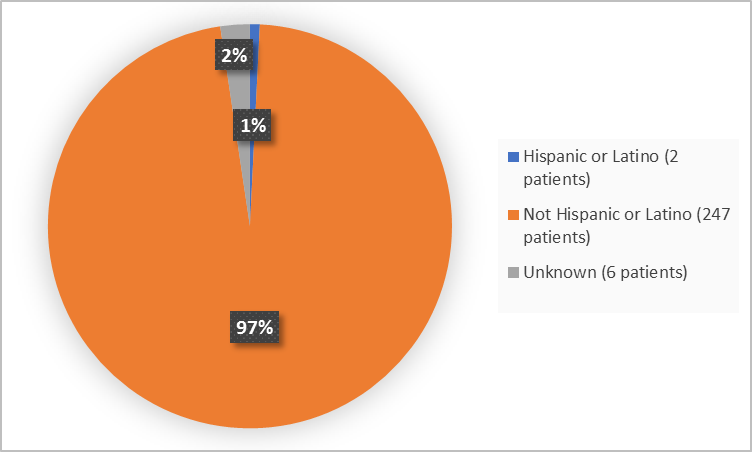Drug Trials Snapshot: TEPMETKO
HOW TO USE THIS SNAPSHOT
The information provided in Snapshots highlights who participated in the key clinical trials that supported the original FDA approval of this drug, and whether there were differences among sex, race, age, and ethnic groups. The “MORE INFO” bar shows more detailed, technical content for each section. The Snapshot is intended as one tool for consumers to use when discussing the risks and benefits of the drugs.
LIMITATIONS OF THIS SNAPSHOT:
Do not rely on Snapshots to make decisions regarding medical care. Always speak to your healthcare provider about the benefits and risks of a drug.
Some of the information in this Snapshot is for presentation purposes and does not represent the approved conditions of use of this drug. Refer to the TEPMETKO Prescribing Information for all of the approved conditions of use of this drug (e.g., indication(s), population(s), dosing regimen(s), safety information).
Snapshots are limited to the information available at the time of the original approval of the drug and do not provide information on who participated in clinical trials that supported later approvals for additional uses of the drug (if applicable).
TEPMETKO (tepotinib)
(tep-MET-co)
EMD Serono
Approval date: February 3, 2021
DRUG TRIALS SNAPSHOT SUMMARY:
What is the drug for?
TEPMETKO is a drug used to treat adult patients with a type of non-small cell lung cancer (NSCLC) which has a specific set of gene alterations and has spread to other parts of the body (metastatic).
How is this drug used?
TEPMETKO is a capsule. Two capsules (450 mg) are taken by mouth once a day.
What are the benefits of this drug?
Thirty of 69 patients (43%) with NSCLC who had not been previously treated and who received TEPMETKO, experienced complete or partial shrinkage of their tumors. Tumor shrinkage lasted more than 6 months for 67% of those patients.
Thirty-six of 83 patients (43%) with NSCLC who had been previously treated and who received TEPMETKO, experienced partial shrinkage of their tumors. Tumor shrinkage lasted more than 6 months for 75% of those patients.
TEPMETKO was approved under FDA’s accelerated approval program, which provides patients earlier access to a promising new drug, while the company continues to conduct clinical trials to confirm that the drug works well.
What are the benefits of this drug (results of trials used to assess efficacy)?
The table below summarizes efficacy results based on overall response rate as determined by a Blinded Independent Review Committee (BIRC) according to Response Evaluation Criteria in Solid Tumors (RECIST) v1.1. An additional efficacy outcome measure was duration of response (DOR) by BIRC.
Table 1. Efficacy Results
|
Efficacy parameter |
Treatment-Naïve |
Previously Treated |
|---|---|---|
|
Overall response rate, % (95% CI) a, b |
43 (32, 56) |
43 (33, 55) |
|
Median duration of response, months c (95% CI) |
10.8 (6.9, NE) |
11.1 (9.5, 18.5) |
|
Patients with DOR ≥ 6 months, % |
67 |
75 |
|
Patients with DOR ≥ 9 months, % |
30 |
50 |
CI=confidence interval, NE=Not estimable
a Blinded Independent Review Committee (BIRC) review
b Confirmed Responses
c Product-limit (Kaplan-Meier) estimates, 95% CI for the median using the Brookmeyer and Crowley method.
Were there any differences in how well the drug worked in clinical trials among sex, race and age?
- Sex: TEPMETKO worked similarly in men and women.
- Race: Almost all patients in the clinical trial were White or Asian. Due to the small number of patients in other racial subgroups, differences among races could not be determined.
- Age: TEPMETKO worked similarly in patients below and above 65 years of age.
Were there any differences in how well the drug worked in clinical trials among sex, race, and age groups?
The tables below summarize overall response rate by sex, race and age subgroups. Results should be interpreted with caution given the small sample size overall, and the limited number of patients in each subgroup.
Table 2. Subgroup Analyses Based on Overall Response Rate -Treatment Naïve Patients
|
Subgroup |
# Patients |
ORR (%) |
95% CI |
|---|---|---|---|
|
Overall |
69 |
43 |
(32, 56) |
|
Age |
|||
|
< 65 years |
8 |
75 |
(35, 97) |
|
≥ 65 years |
61 |
39 |
(27, 53) |
|
Sex |
|||
|
Male |
36 |
44 |
(28, 62) |
|
Female |
33 |
42 |
(25, 61) |
|
Race |
|||
|
White |
56 |
39 |
(26, 53) |
|
Asian |
12 |
58 |
(28, 85) |
|
Other/ Missing |
1 |
100 |
(3, 100) |
|
Region |
|||
|
US |
17 |
53 |
(28, 77) |
|
Non-US |
52 |
40 |
(27, 55) |
Adapted from sponsor submission
Table 3. Subgroup Analyses Based on Overall Response Rate - Previously Treated Patients
|
Subgroup |
# Patients |
ORR (%) |
95% CI |
|---|---|---|---|
|
Overall |
83 |
43 |
(33, 55) |
|
Age |
|||
|
< 65 years |
19 |
37 |
(16, 62) |
|
≥ 65 years |
64 |
45 |
(33, 58) |
|
Sex |
|||
|
Male |
43 |
44 |
(29, 60) |
|
Female |
40 |
42 |
(27, 59) |
|
Race |
|||
|
White |
52 |
44 |
(30, 59) |
|
Asian |
26 |
42 |
(23, 63) |
|
Other/ Missing* |
5 |
40 |
(5, 85) |
|
Region |
|||
|
US |
23 |
43 |
(23, 66) |
|
Non-US |
60 |
43 |
(31, 57) |
*Includes 1 black patient who did not have a response
Adapted from sponsor submission
What are the possible side effects?
TEPMETKO may cause serious side effects including lung inflammation, liver toxicity, laboratory abnormalitites (including decreased lymphocytes, decreased albumin, decreased sodium, and decreased hemaglobin), and harm to an unborn baby.
The most common side effects of TEPMETKO are swelling of hands and feet, tiredness, nausea, diarrhea, muscle and joint pain, and shortness of breath.
What are the possible side effects (results of trials used to assess safety)?
The table below summarizes adverse reactions that occurred in ≥10% of patients treated with TEPMETKO.
Table 4. Adverse Reactions (≥ 10%) in Patients Who Received TEPMETKO
|
Adverse Reactions |
TEPMETKO |
|
|---|---|---|
|
All Grades |
Grades 3 to 4 |
|
|
General disorders and administration-site conditions |
||
|
Edema a |
70 |
9 |
|
Fatigue b |
27 |
1.6 |
|
Gastrointestinal disorders |
||
|
Nausea |
27 |
0.8 |
|
Diarrhea |
26 |
0.4 |
|
Abdominal Pain c |
16 |
0.8 |
|
Constipation |
16 |
0 |
|
Vomiting d |
13 |
1.2 |
|
Musculoskeletal and Connective Tissue Disorders |
||
|
Musculoskeletal Pain e |
24 |
2.4 |
|
Respiratory, thoracic, and mediastinal disorders |
||
|
Dyspnea f |
20 |
2 |
|
Cough g |
15 |
0.4 |
|
Pleural effusion |
13 |
5 |
|
Metabolism and nutrition disorders |
||
|
Decreased appetite |
16 |
1.2 |
|
Infections and Infestations |
||
|
Pneumonia h |
11 |
3.9 |
a Edema includes eye edema, face edema, generalized edema, localized edema, edema, genital edema, peripheral edema, peripheral swelling, periorbital edema, and scrotal edema.
b Fatigue includes asthenia and fatigue.
c Abdominal Pain includes abdominal discomfort, abdominal pain, abdominal pain lower, abdominal pain upper,gastrointestinal pain and hepatic pain.
d Vomiting includes retching and vomiting.
e Musculoskeletal Pain includes arthralgia, arthritis, back pain, bone pain, musculoskeletal chest pain, musculoskeletal pain, myalgia, non-cardiac chest pain, pain in extremity, and spinal pain.
f Dyspnea includes dyspnea, dyspnea at rest, and dyspnea exertional.
g Cough includes cough, and productive cough.
h Pneumonia includes pneumonia, pneumonia aspiration, and pneumonia bacterial.
Were there any differences in side effects of the clinical trials among sex, race, and age?
- Sex: The occurrence of side effects was similar in men and women.
- Race: Almost all patients in the clinical trial were White or Asian. Due to the small number of patients in other racial subgroups, differences in side effects among races could not be determined.
- Age: The observed rates of side effects including Grades 3 to 4 side effects was greater in the older age groups than among those less than 65 years of age.
Were there any differences in side effects of the clinical trials among sex, race, and age groups?
The table below summarizes the most common adverse reactions of patients treated with TEPMETKO by sex, race, and age.
Table 5. Most Common Adverse Events by Sex, Race and Age (safety population)
|
Demographic Variable |
TEPMETKO |
||
|---|---|---|---|
|
All Patients |
All Grades |
Grades 3 to 4 |
|
|
Sex |
|||
|
Men |
123 (48.2) |
110/123 (89.4) |
26/123 (21.1) |
|
Women |
132 (51.8) |
118/132 (89.4) |
29/132 (22.0) |
|
Race |
|||
|
White |
171 (67.1) |
154/171 (90.1) |
42/171 (24.6) |
|
Asian |
72 (28.2) |
65/72 (90.3) |
10/72 (13.9) |
|
Black or African American |
3 (1.2) |
1/3 (33.3) |
1/3 (33.3) |
|
Other |
1 (0.4) |
1/1 (100) |
0/1 (0) |
|
Unknown |
8 (3.1) |
7/8 (87.5) |
2/8 (25.0) |
|
Age category |
|||
|
<65 years |
53 (20.8) |
43/53 (81.1) |
3/53 (5.7) |
|
≥ 65 to <75 years |
93 (36.5) |
87/93 (93.5) |
23/93 (24.7) |
|
≥ 75 to <85 years |
89 (34.9) |
79/89 (88.8) |
22/89 (24.7) |
|
≥ 85 years |
20 (7.8) |
19/20 (95.0) |
7/20 (35.0) |
Ns, total number of patients for each specific subgroup
Adapted from FDA review
WHO WAS IN THE CLINICAL TRIALS?
Who participated in the clinical trials?
The FDA approved TEPMETKO based on the evidence from one clinical trial (NCT02864992) of 255 patients with metastatic NSCLC which had MET exon 14 skipping alterations. The trial was conducted at 81 sites in the United States, France, Germany, Italy, Belgium, Poland, Spain, South Korea, Taiwan and Japan.
All 255 patients that provided data for the assessment of side effects of TEPMETKO (safety population) are presented below. Some of these patients (152) provided data for the assessment of the benefits of TEPMETKO (efficacy population) which are presented in Table 7 under MORE INFO.
Figure 1 below summarizes by sex how many patients were in the clinical trial.
Figure 1. Demographics by Sex (safety population)
Adapted from FDA Review
Figure 2 summarizes the percentage of patients in the clinical trial by race.
Figure 2. Demographics by Race (safety population)
Adapted from FDA Review
Figure 3 below summarizes the percentage of patients in the clinical trial by age.
Figure 3. Demographics by Age (safety population)
Adapted from FDA Review
Figure 4 below summarizes the percentage of patients in the clinical trial by ethnicity.
Figure 4. Demographics by Ethnicity (safety population)
Adapted from FDA Review
Who participated in the trials?
Table 6 below summarizes demographics for the patients with metastatic NSCLC harboring MET mutation, who received at least one dose of TEPMETKO (safety population). Demographics of the patients in the efficacy population is presented in Table 7.
Table 6. Demographics of Patients in the Clinical Trial (safety population)
|
Demographic Variable |
TEPMETKO |
|---|---|
|
Sex,n (%) |
|
|
Men |
123 (48.2) |
|
Women |
132 (51.8) |
|
Race,n (%) |
|
|
White |
171 (67.1) |
|
Asian |
72 (28.2) |
|
Black or African American |
3 (1.2) |
|
Other |
1 (o.4) |
|
Unknown |
8 (3.1) |
|
Age (years) |
|
|
Mean (SD) |
72.5 (9.04) |
|
Median |
72.0 |
|
Minimum, Maximum |
41.0,94.0 |
|
Age category, n (%) |
|
|
<65 years |
53 (20.8) |
|
≥ 65 to <75 years |
93 (36.5) |
|
≥ 75 to <85 years |
89 (34.9) |
|
≥ 85 years |
20 (7.8) |
|
Ethnicity,n (%) |
|
|
Hispanic or Latino |
2 (0.8) |
|
Not Hispanic or Latino |
247 (96.9) |
|
Unknown |
6 (2.4) |
|
Region,n (%) |
|
|
Unites States |
54 (21.2) |
|
Rest of the World |
201 (78.8) |
Adapted from FDA Review
Table 7. Demographics of Patients in the Clinical Trial (efficacy population)
|
Demographic Variable |
Treatment-Naïve N = 69 |
Previously N = 83 |
Total N = 152 |
|---|---|---|---|
|
Sex, n (%) |
|||
|
Men |
36 (52.2) |
40 (48.2) |
79 (52.0) |
|
Women |
33 (47.8) |
43 (51.8) |
73 (48.0) |
|
Race, n (%) |
|||
|
White |
56 (81.2) |
52 (62.7) |
108 (71.1) |
|
Asian |
12 (17.4) |
26 (31.3) |
38 (25.0) |
|
Not collected at site |
1 (1.4) |
4 (4.8) |
4 (2.6) |
|
Other |
0 (0.0) |
1 (1.2) |
1 (0.7) |
|
Age (years) |
|||
|
Mean (StD) |
74.6 (± 7.92) |
71.7 (± 9.89) |
73.0 (± 8.97) |
|
Median (Q1, Q3) |
74.0 (68.9, 81.0) |
72.8 (65.0, 79.8) |
73.1 (68.1, 79.9) |
|
Min, Max |
56, 94 |
41, 88 |
41, 94 |
|
Age groups, n (%) |
|||
|
< 65 years |
8 (11.6) |
19 (22.9) |
27 (17.8) |
|
≥ 65 years |
61 (88.4) |
64 (77.1) |
125 (82.2) |
|
65 to < 75 years |
29 (42.0) |
28 (33.7) |
57 (37.5) |
|
75 to < 85 years |
26 (37.7) |
32 (38.6) |
58 (38.2) |
|
≥ 85 years |
6 (8.7) |
4 (4.8) |
10 (6.6) |
|
Ethnicity, n (%) |
|||
|
Not Hispanic or Latino |
68 (98.6) |
80 (96.4) |
148 (97.4) |
|
Missing |
0 (0.0) |
3 (3.6) |
3 (2.0) |
|
Country, n (%) |
|||
|
United States |
17 (24.6) |
23 (27.7) |
40 (26.3) |
|
France |
11 (15.9) |
15 (18.1) |
26 (17.1) |
|
Japan |
10 (14.5) |
9 (10.8) |
19 (12.5) |
|
Spain |
7 (10.1) |
10 (12.0) |
17 (11.2) |
|
Germany |
9 (13.0) |
6 (7.2) |
15 (9.9) |
|
Italy |
7 (10.1) |
5 (6.0) |
12 (7.9) |
|
South Korea |
1 (1.4) |
9 (10.8) |
10 (6.6) |
|
Taiwan |
0 (0.0) |
5 (6.0) |
5 (3.3) |
|
Belgium |
2 (2.9) |
1 (1.2) |
3 (2.0) |
|
Poland |
2 (2.9) |
0 (0.0) |
2 (1.3) |
Adapted from FDA Review
How were the trials designed?
The benefit and side effects of TEPMETKO for metastatic NSCLC with MET mutation were evaluated in one clinical trial. Some patients were previously treated for their cancer and some were not (treatment-naïve).
Patients received TEPMETKO once a day until either they had cancer progression or intolerable side effects.
The benefit of TEPMETKO was evaluated by measuring the percentage of patients who achieved complete or partial shrinkage of their tumors (overall response rate) and by measuring the duration of that benefit (duration of response).
How were the trials designed?
There was one multicenter, non-randomized, open-label, multi-cohort trial that provided data to evaluate safety and the efficacy of TEPMETKO for patients with metastatic NSCLC with an alteration that leads to MET exon 14 skipping. Patients received TEPMETKO 450 mg orally twice daily until unacceptable toxicity or disease progression.
The major efficacy outcome measures were overall response rate and duration of response as determined by a blinded independent review committee according to RECIST v1.1.
Safety assessment was done on all patients who received at least one dose of TEPMETKO.
GLOSSARY
CLINICAL TRIAL: Voluntary research studies conducted in people and designed to answer specific questions about the safety or effectiveness of drugs, vaccines, other therapies, or new ways of using existing treatments.
COMPARATOR: A previously available treatment or placebo that is compared to the actual drug being tested.
EFFICACY: How well the drug achieves the desired response when it is taken as described in a controlled clinical setting, such as during a clinical trial.
PLACEBO: An inactive substance or “sugar pill” that looks the same as, and is given the same way as, an active drug or treatment being tested. The effects of the active drug or treatment are compared to the effects of the placebo.
SUBGROUP: A subset of the population studied in a clinical trial. Demographic subsets include sex, race, and age groups.




